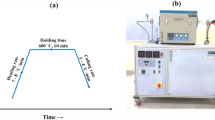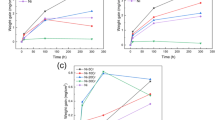Abstract
The effect of implantation of argon, oxygen, and nitrogen ions on the physicochemical structure of the surface and the corrosion and electrochemical behavior of chromium-nickel steel 03Cr18Ni11 has been studied. Methods of electrochemical polarization (EP), atomic force microscopy (AFM), and X-ray photoelectron spectroscopy (XPS) were used. Ion implantation of argon, oxygen, and nitrogen leads to an increase in the corrosion resistance of steel 03Cr18Ni11 both in a neutral environment and in the presence of a corrosion activator (chloride anions), while irradiation with argon ions is most effective. It is found that, after implantation of argon ions, a partial etching of the steel surface occurs, i.e., an increase in the true surface. This, in turn, facilitates the onset of the passive state. At the same time, the use of oxygen and nitrogen ions leads to smoothing of the surface. AFM data indicate that the studied steel treated with argon ions exhibits the greatest resistance to local corrosion. The implantation of oxygen and argon ions reduces the overall corrosion to the greatest extent. It is important to note that deep craters and traces of pitting corrosion do not form on the surface of the steel. The XPS data show that after ion implantation, there is a change in the concentration of the elements that make up the steel in the near-surface layers of the material in the depth of the implanted layer compared with the unirradiated sample. It is established that the surface layers of steel are enriched in chromium atoms during ion implantation. This process occurs most intensively when samples are treated with argon ions. In this case, mixed chromium and iron oxides are formed, contributing to the passivation of the steel surface. Also, the process of ion implantation is accompanied by oxidation of the surface of the steel under study. This is confirmed by an increase in the oxygen content in the surface layers. To the greatest extent, this process occurs during the implantation of oxygen ions. After corrosion tests, an increased chromium content is also observed on the surface of steel treated with Ar+ ions, which confirms the formation in this case of stable chromium oxides that remain on the surface during the corrosion of steel. The analysis of the fine structure of the XPS spectra showed that, under the action of argon ions, the oxygen of surface oxides is redistributed in favor of chromium atoms and the formation of stable mixed iron and chromium oxides of the spinel type, including Fe2+, Fe3+, Cr3+, and Cr6+ compounds. It is important to note that, although chromium oxides are also formed during oxygen implantation and in the same quantities as during argon implantation, the protective properties of the resulting compounds are noticeably lower. Therefore, not only the chemical composition but also the structure of the resulting layers are important. It can be assumed that the high kinetic energy of heavy argon ions affects both the formation of developed surface relief and the formation of stable mixed iron and chromium oxides of the spinel type.






Similar content being viewed by others
REFERENCES
Semenova, I.V., Florianovich, G.M., and Khoroshilov, A.V., Korroziya i zashchita ot korrozii (Corrosion and Corrosion Prevention), Moscow: Fizmatlit, 2002.
Zamaletdinov, I.I., Shein, A.B., and Kichigin, V.I., Lokal’naya korroziya liteinykh i poroshkovykh stalei (Local Corrosion of Cast and Powder Steels), Perm: Perm State Nat. Res. Univ., 2015.
Komarov, F.F., Ionnaya implantatsiya v metally (Ion Implantation in Metals), Moscow: Metallurgiya, 1990.
Reyntjens, S. and Puers, R., A review of focused ion beam applications in microsystem technology, J. Micromech. Microeng., 2001, vol. 11, pp. 287–300. https://doi.org/10.1088/0960-1317/11/4/301
Chen, Q. and Thouas, G.A., Metallic implant biomaterials, Mater. Sci. Eng., R, 2015, vol. 87, pp. 1–57. https://doi.org/10.1016/j.mser.2014.10.001
Bairamov, A.Kh., Ionic alloying and metal corrosion, Itogi Nauki Tekh., Ser.: Korroz. Zashch. Korroz., 1982, vol. 9, pp. 139–172.
Vorob’ev, V.L., Bykov, P.V., Bayankin, V.Ya., Bystrov, S.G., Porsev, V.E., Bureev, O.A., Shushkov, A.A., and Vakhrushev, A.V., Change of composition and hardness of the near-surface layers of carbon steel with increasing accelerating voltage at pulse irradiation with Cr+ ions, Fiz. Khim. Obrab. Mater., 2015, no. 1, pp. 26–31.
Bystrov, S.G., Pepelyaev, N.B., Reshetnikov, S.M., Kolotov, A.A., and Bayankin, V.Ya., The influence of argon ions implantation on a physical and chemical structure and corrosive-electrochemical behaviour of the high-chromium steel, Khim. Fiz. Mezosk., 2017, vol. 19, no. 2, pp. 250–258.
Bystrov, S.G., Reshetnikov, S.M., Kolotov, A.A., Drozdov, A.Yu., and Bayankin, V.Ya., Effect of oxygen ion implantation on physicochemical structure and corrosion-electrochemical behavior of high-chromium steel, Inorg. Mater.: Appl. Res., 2021, vol. 12, no. 3, pp. 625–632. https://doi.org/10.1134/S2075113321030060
Lakhtin, Yu.M., Kogan, Ya.D., Shpis, G.I., and Boehmer, Z., Teoriya i tekhnologiya azotirovaniya (Theory and Technology of Nitriding), Moscow: Metallurgiya, 1991.
Sukhotin, A.M., Fizicheskaya khimiya passiviruyushchikh plenok na zheleze (Physical Chemistry of Passivating Films on Iron), Leningrad: Khimiya, 1989.
Wagner, C.D., Riggs, W.M., Davis, L.E., and Moulder, J.F., Handbook of X-Ray Photoelectron Spectroscopy, Eden Prairie, Minnesota: Perkin-Elmer, Phys. Electron. Div., 1979.
Bystrov, S.G., Reshetnikov, S.M., Pepelyaev, N.B., Makletsov, V.G., Surnin, D.V., and Bayankin, V.Ya., Research of initial stages of the local corrosion process of chromium steel (13% Cr) by the methods of atomic force microscopy, Auger electron spectroscopy and X-ray photoelectron spectroscopy, Khim. Fiz. Mezosk., 2016, vol. 18, no. 1, pp. 79–89.
Bystrov, S.G., Reshetnikov, S.M., Borisova, E.M., Klimova, I.N., Kolotov, A.A., Zhikharev, A.V., and Bayankin, V.Ya., Effect of implantation of argon and oxygen ions on the physicochemical properties and corrosion and electrochemical behavior of 14Cr17Ni2 chromium–nickel steel, Inorg. Mater.: Appl. Res., 2022, vol. 13, no. 3, pp. 666–673. https://doi.org/10.1134/S207511332103008X
Kharanzhevskiy, E.V., Krivilyov, M.D., Reshetnikov, S.M., Sadiokov, E.E., and Gil’mutdinov, F.Z., Corrosion-electrochemical behavior of nanostructured chromium oxide layers obtained by laser irradiation of unalloyed steel by short pulses, Prot. Met. Phys. Chem. Surf., 2014, vol. 50, pp. 777–783. https://doi.org/10.1134/S2070205114060070
NIST X-Ray Photoelectron Spectroscopy Database. https://srdata.nist.gov/xps/Default.aspx
Akimov, A.G., Regularities of the formation of protective oxide layers in metal (alloy)–medium systems, Zashch. Met., 1986, vol. 22, no. 6, pp. 879–886.
Volkov, V.L., Zakharova, G.S., and Kuznetsov, M.V., Polyvanadievochromic acid, Zh. Neorg. Khim., 1994, vol. 39, no. 6, pp. 877–882.
ACKNOWLEDGMENTS
This study was performed using the facilities of the center for shared access Center for Physical and Physicochemical Methods of Analysis, Study of Properties, and Characteristics of Surfaces, Nanostructures, Materials, and Products of the Udmurt Federal Research Center of the Ural Branch of the Russian Academy of Sciences.
Funding
This work was supported by the Ministry of Science and Higher Education and conducted within the framework of the Federal Target Program “Research and Development in Priority Areas of Development of the Scientific and Technological Complex of the Russian Federation for 2014–2020” (project no. RFMEFI62119X0035).
Author information
Authors and Affiliations
Corresponding authors
Ethics declarations
The authors of this work declare that they have no conflicts of interest.
Additional information
Translated by N. Saetova
Publisher’s Note.
Pleiades Publishing remains neutral with regard to jurisdictional claims in published maps and institutional affiliations.
Rights and permissions
About this article
Cite this article
Bystrov, S.G., Reshetnikov, S.M., Kolotov, A.A. et al. Changes in the Composition and Corrosion-Electrochemical Properties of the Chromium-Nickel Steel 03Cr18Ni11 During Implantation of Argon, Oxygen, and Nitrogen Ions. Inorg. Mater. Appl. Res. 15, 617–625 (2024). https://doi.org/10.1134/S2075113324700047
Received:
Revised:
Accepted:
Published:
Issue Date:
DOI: https://doi.org/10.1134/S2075113324700047




